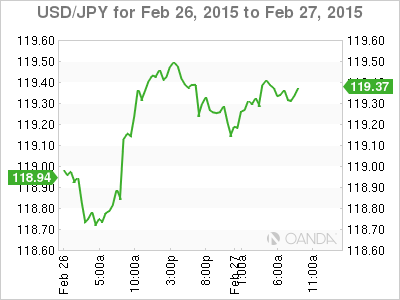The Japanese yen is unchanged on Friday, as USD/JPY trades in the mid-119 range. On the release front, the US will issue its second estimate of GDP for Q4, with a forecast of 2.1%. This is lower than the initial estimate of 2.6% in January. We’ll also get a look at Revised UoM Consumer Sentiment and Pending Home Sales. In Japan, today’s only event was Housing Starts. The indicator posted a weak reading of -13.0%.
Japanese data was a mix on Thursday. Inflation indicators met expectations in February. Tokyo Core CPI was unchanged at 2.2%, matching the forecast. National Core CPI posted an identical gain, close to the estimate of 2.4%. Consumer spending looked awful. Household Spending plunged 5.1%, worse than the estimate of -4.0%. Retail Sales had its worst showing since May, with a decline of 2.0%. The markets had expected a softer decline of 1.2%. There was some good news on the manufacturing front, as Preliminary Industrial Production climbed 4.0%, well above the forecast of 2.9%.
Thursday’s US inflation and job numbers were not impressive. US inflation indicators continue to struggle. CPI posted a third straight decline, coming in at -0.7%. This was very close to the forecast of -0.6%. Core CPI improved to 0.2%, edging above the estimate of 0.1%. On the employment front, there was disappointing news, as Unemployment Claims jumped to a 6-week high, coming in at 313 thousand. This was much higher than the estimate of 288 thousand.
Janet Yellen testified before Congressional committees on Tuesday and Wednesday, saying that the Fed was “unlikely” to raise interest rates in the next few months, given current economic conditions. Her remarks seemed aimed at quelling rising speculation about a rate hike sometime in mid-2015, which has helped boost the US dollar’s performance against its major rivals. Yellen noted that the continuing economic growth should lead to unemployment continuing to fall, but wages and inflation need to move higher before the Fed raises interest rates.
USD/JPY 119.34 H: 119.44 L: 119.12
This article is for general information purposes only. It is not investment advice or a solution to buy or sell securities.
Opinions are the authors — not necessarily OANDA’s, its officers or directors. OANDA’s Terms of Use and Privacy Policy apply. Leveraged trading is high risk and not suitable for all. You could lose all of your deposited funds.
Recommended Content
Editors’ Picks
AUD/USD jumps above 0.6500 after hot Australian CPI data

AUD/USD extended gains and recaptured 0.6500 in Asian trading, following the release of hotter-than-expected Australian inflation data. The Australian CPI rose 1% in QoQ in Q1 against 0.8% forecast, providing extra legs to the Australian Dollar upside.
USD/JPY hangs near 34-year high at 154.88 as intervention risks loom

USD/JPY is sitting at a multi-decade high of 154.88 reached on Tuesday. Traders refrain from placing fresh bets on the pair as Japan's FX intervention risks loom. Broad US Dollar weakness also caps the upside in the major. US Durable Goods data are next on tap.
Gold price cautious despite weaker US Dollar and falling US yields

Gold retreats modestly after failing to sustain gains despite fall in US Treasury yields, weaker US Dollar. XAU/USD struggles to capitalize following release of weaker-than-expected S&P Global PMIs, fueling speculation about potential Fed rate cuts.
Crypto community reacts as BRICS considers launching stablecoin for international trade settlement

BRICS is intensifying efforts to reduce its reliance on the US dollar after plans for its stablecoin effort surfaced online on Tuesday. Most people expect the stablecoin to be backed by gold, considering BRICS nations have been accumulating large holdings of the commodity.
US versus the Eurozone: Inflation divergence causes monetary desynchronization

Historically there is a very close correlation between changes in US Treasury yields and German Bund yields. This is relevant at the current juncture, considering that the recent hawkish twist in the tone of the Fed might continue to push US long-term interest rates higher and put upward pressure on bond yields in the Eurozone.
